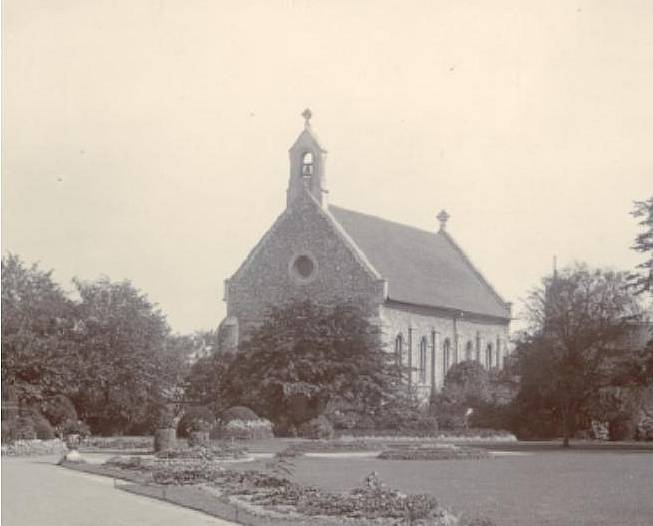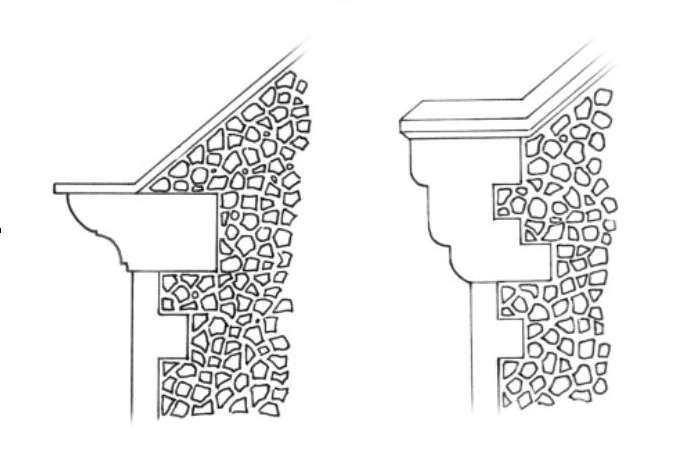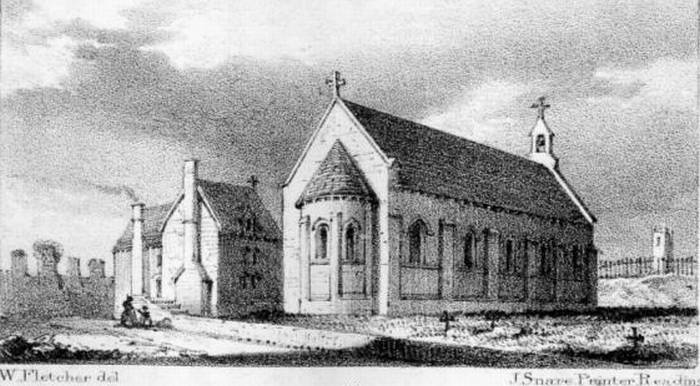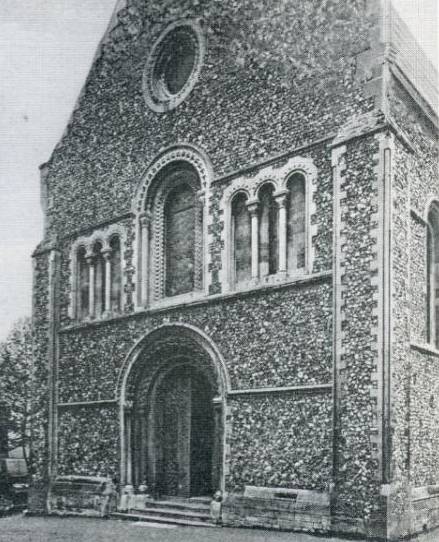Excerpted with permission from Reformation, Revolution and Rebirth: The Story of the Return of Catholicism to Reading and the Founding of St James' Parish by John Mullaney and Lindsay Mullaney (Reading: Scallop Shell Press, 2012), pp. 112-146, and reformatted for the Victorian Web by Jacqueline Banerjee. All images come from the book, and reproduction rights belong to the authors or to those indicated in the credits. Click on the images for larger pictures. For more information about the book, please visit the Scallop Shell Press website.
The Roof
Pitch: Principle: "The pitch of the roof: the most beautiful pitch of a roof or gable-end is an inclination sufficiently steep to throw off snow without giving the covering too perpendicular a strain; it is formed by two sides of an equilateral triangle. If this form is departed from, the gable appears either painfully acute or too widely spread. All really beautiful forms of architecture are based on the sound principles of utility. The practical aspect is that the correct pitch ensures the wind pressure bears down on the roof covering and not allowing the wind to blow under it so lifting it up."


Left: Modern view. Right: Photograph by Henry Taunt, 1880s.
Pugin stated that if that formula is departed from the "gable appears either painfully acute or too widely spread." Pugin may have been strict in voicing his principles but at times principles may throw up apparent contradictions. Does the roof of St James' follow the equilateral principle and what is its impact?
Questions need to be asked as to whether he had formulated this principle by 1837 and when did he in fact apply it. I have compared the façades of several early designs such as St Michael's, Gorey, and St Peter's College, Wexford, and we see similar pitches in both these cases. Indeed if we look at Cheadle, his masterpiece, it would appear that he maintains a flexible attitude to pitch. Whatever Pugin's thinking in stating his principle about the angle of the pitch, he repeatedly commented on the necessity to take the local climatic conditions into account. He comments in the [True] Principles... that: "our northern climate requires an acute pitch of roof to prevent the accumulation of snow and to resist weather."

Sprocketed roof at St James'.
At St James', the pitch accommodates the eaves by splaying slightly outwards, a technique known as a sprocketed roof. This method is employed when using roof beams and associated eaves that need to project well over the walls of the structure. It is noticeable that in the Fletcher-Wheble drawing [see The East End, below] this refinement is not present. A practical advantage of a sprocketed roof is that it allows greater depth to the eaves and so aids the anti-weathering process as rain-water is taken away from the walls. It also serves the important purpose of slowing down the flow of water.
Gables

Evolution of the kneeler. To the left a standard kneeler from the 18th century: to the right Pugin's early kneeler design as found at St James' (© J. R. Mullaney)
The gable copings and kneelers are of especial interest. In the Fletcher-Wheble drawing the kneeler and the corbel of the northwest gable appear to be missing, whereas they are present on the eastern gable. In fact on the actual building they are very prominent and this is a feature of Pugin's early designs. The coping stones of the gable are rounded and project out horizontally, at the base of the gable, quite significantly. In this way they become integrated with the kneeler, resting on the shaped corbel some way below. They share these features with St Michael's, Co. Wexford. As Brian Andrews comments in his work about Gorey, Pugin's "mature treatment of this detail had flat-topped coping stones, often terminating in a gablet, with the corbel generally directly below the kneeler."
The East End


[The Fletcher-Wheble drawing, on the right here, is reproduced by courtesy of Reading Library.]
The eastern gable is likewise remarkable. The internal rounded chancel apse is reflected on the outside by the construction of the semi-conical roof which, before the addition of the ambulatory in the 1960s, gave the church its unique compact appearance. The use of dressed stone rather than flint for part of east end is also worth noting. As I said before, it would appear that the stone was only used down to the level of the eaves of the conical roof, although on the Fletcher-Wheble drawing it would appear the intention was that it should be used for the whole gable. It is worth observing that Pugin only employed the use of a rounded apse in his Romanesque designs, namely in St James', St Michael's, and in the crypt of St Chad's.
Mouldings
Principle: "Mouldings are the enrichment of splays, doorways, windows, arches, piers, bases and string-courses, of weatherings and copings, and they are introduced solely on the principle of decorating the useful."
Mouldings, as well as adding to the "enrichment" of a building, are also part of the "essential construction." Splays allow extra light in the case of windows and at the base of buildings they protect and shed water off plinths. Mouldings, when used, should therefore reinforce these purposes. For the sake of beauty Pugin demanded that their effect on shadows must be considered. Gradations of light avoid monotony and enhance the beauty of the building.
The purpose of the essential construction of doorways is to allow access and egress. They should be the right width for their purpose and any ornament should contribute practically and aesthetically to this end. So, in the case of a door jamb, the mouldings should not project, as this would counteract the purpose of a splayed jamb: to increase width of access.
However the opposite is true for the outside of windows. There needs to be a hood mould projecting immediately above the arch to "receive water running down the wall." The mould is not a mere ornament but part of the "essential construction" of directing water run-off. Note that the mouldings around the arch of the west door at St. James' are more divided than around the jamb. Why? This follows the same principle as found in nature "where the solid trunk spreads and divides as it rises upwards" — recalling the Vitruvian principle of venustas. Likewise where the arch joins the jambs, at the springing, continuity is best achieved through the use of foliated and moulded projections. Where the same moulding is used, from jamb through to arch, then there is no need for caps (small capitals).


Both pictures, courtesy of St James' Church.
The mouldings are an integral part of the design. As Pugin says in his Apology [for the Revival of Christian Architecture,] it is essential that "ornament is originated" by the edifice and not superimposed, or "adapted" as he puts it, onto the design. So, if we examine the west front, we see that the moulding over the door and windows carries on, becoming a string-course and so not only pleases the eye, but also serves a practical function. As noted above, this technique also serves to draw the eye back to the centre of the building. More specifically, at ground level the onlooker's gaze is led to the west door and so upwards.
Should the eye linger on the projections of the buttresses, then it is directed not inwards but upwards, to the coping which meets with another string-course moulding. Thus it completes the process of returning the focus of attention back to the centre of the building, to the rounded arch, up towards the oculus and so to the bellcote and, originally, the cross. Just in case the eye wanders again, the bevelled coping at the top of the buttresses points to the corbels and kneelers which in turn draw the eye to the gable coping and so back to the bellcote.
Pugin emphasises the need for splayed or bevelled coping, be it at the base of the building or surmounting any projection, such as we see on the top of the buttresses at St James'. If this were not so "they would become lodgments for water," he says. At St James' each buttress has a bevelled or splayed top. It is worth noting the repeated use of scalloped decoration, a feature, almost an idée fixe, throughout the Church. We must assume this is a conscious reference to the symbolic significance of the scallop shell and its association with St James of Compostela. The ancient Abbey of Reading and the new Church share this religious connection, both being dedicated to St James.
Little remains of the north or south sides of Pugin's original design. We can, however, see that his use of mouldings over the windows, and their associated string-courses, projecting along the length of the building, serve a twofold function. There is once again their practical weathering purpose but aesthetically they serve to accentuate the unity of the building. Pugin retains a balance between the vertical and perpendicular and this is achieved through his careful placing of the splayed, round-arched windows and buttresses linked by the string-courses, which, as we saw above, are a continuation of the hood-moulds.
The Mouldings and the West Door
Before looking more closely at the mouldings, it is worth noting how the plinths are splayed or bevelled to take water away from the base of the building. This technique also draws the eye upwards and in the case of the doorway, into the church. It is quite remarkable how closely the door mouldings follow those in The True Principles.


Left: From True Principles. Right: The west door of St James'.
Pugin argues that a doorway needs not only to be large and properly proportioned but its ornament must complement its structural purpose. If we examine the proportions of the doorway at St. James', we see that the splay doubles the apparent size of the actual door opening. The width, Pugin argues, must not be increased or reduced by the depth of the mouldings. If too shallow they will produce an appearance of weakness in the jamb, if they project too far then the opening is narrowed and becomes inconvenient.
Note the use, at St James, of typical Norman Romanesque zigzag mouldings. It is interesting to see the scalloping theme being repeated on the outside "order." The "caps" are likewise fluted or scalloped. This is a theme repeated throughout both the interior and exterior of the Church and is even found on the guttering and rain pipes. Mangan copied this in his 1926 alterations.
When looking at the buttresses we saw how Pugin insisted that the outline of the quoin stones must not interfere with the impact of the mouldings. Once again this is achieved by the use of irregular projections of the stones around the door jamb. The same is true for the windows above.
In the Principles Pugin lays great stress on the bonds and joints. In his drawings, below, Pugin demonstrates how large blocks of stone detract from the overall effect of a window or a door. The "eye," he says, "owing to the regularity of these projections, is carried from the line of the jamb to them." In the pictures below Pugin illustrates how, in the case of the top two, the eye is drawn towards the buttresses in the right hand picture, whilst the focal point is the window in the left hand drawing. In the case of the lower two drawings, in the left hand window the regular jamb stones lead the eye to the periphery of the window whilst in the right hand picture the irregular and smaller jambs accentuate the window itself.

From True Principles.
If we look at St James', we see that the stones are of irregular size and projection. This is true both for the upper windows and the door. Far from the eye being drawn outwards and so concentrating on them, the stones become barely noticeable.
The string-courses not only satisfy the eye by continuing the line of the caps at the top of the column and base of the arch, but also serve the practical purpose of throwing the water off the wall and down to the next bevel, which in this case is the base of the building.
Pugin states that "all mouldings should be designed on the principle of light, shadow and half tint, so as to produce pleasing gradations of light and shadow." This aesthetic feature corresponds to the practical function of splays. In other words the projections caused by mouldings must follow the line of the splay and not protrude so as to interfere with access. At the same time the very same projections cause a play of light and shadow which enhances the beauty of the building. As Pugin puts it, a "projecting mould in such a situation would be a useless excrescence." The importance of light leads us to Pugin's next topic for consideration, that of windows.
Related Material
- 1. A. W. N. Pugin's First Church, St James', Reading
- 2. The Original Design and the Norman Romanesque Style
- 4. The True Principles and Their Application to St James' (Part 1)
- 5. The True Principles and Their Application to St James' (Part 3)
- 6. Bibliography and Sources
Last modified 22 December 2012